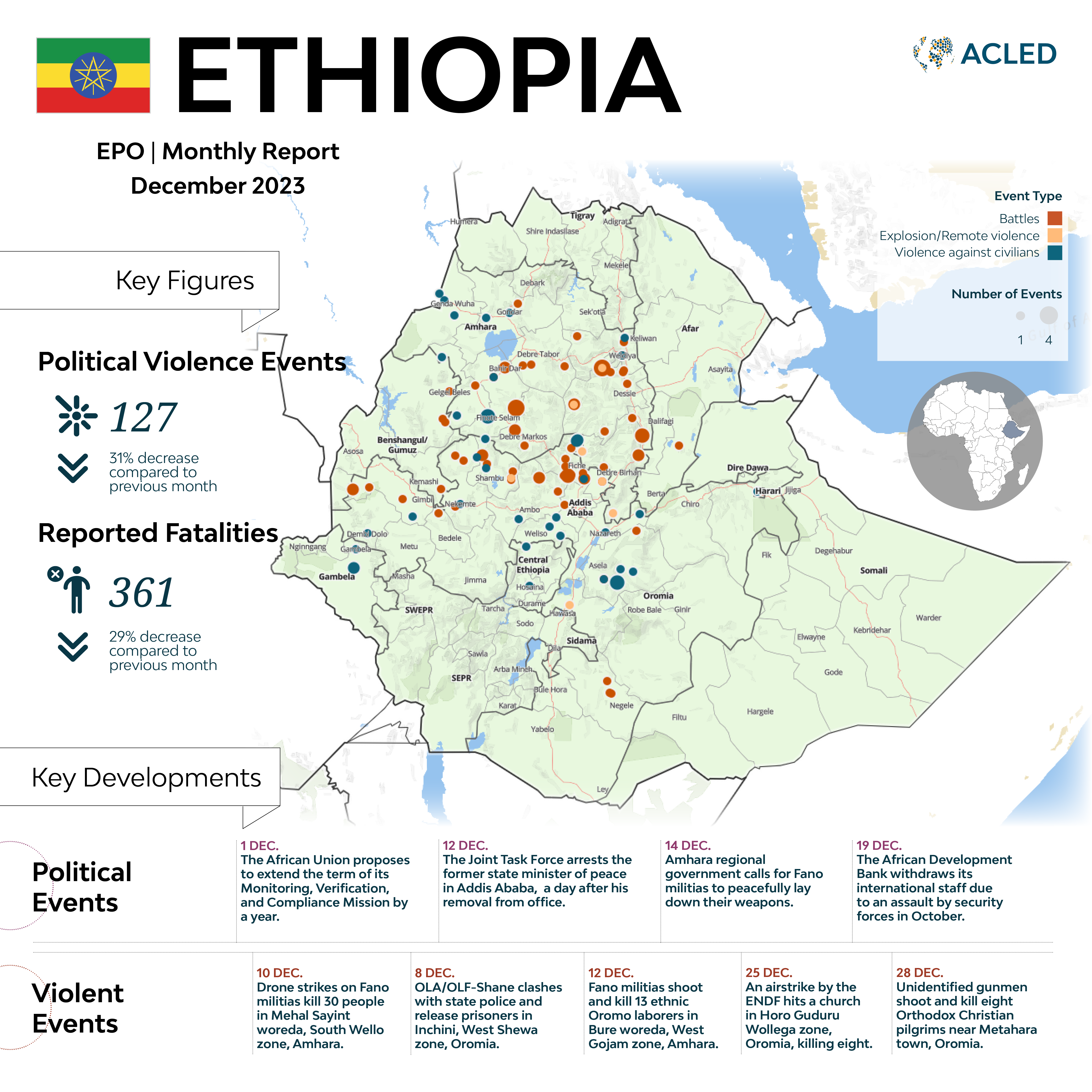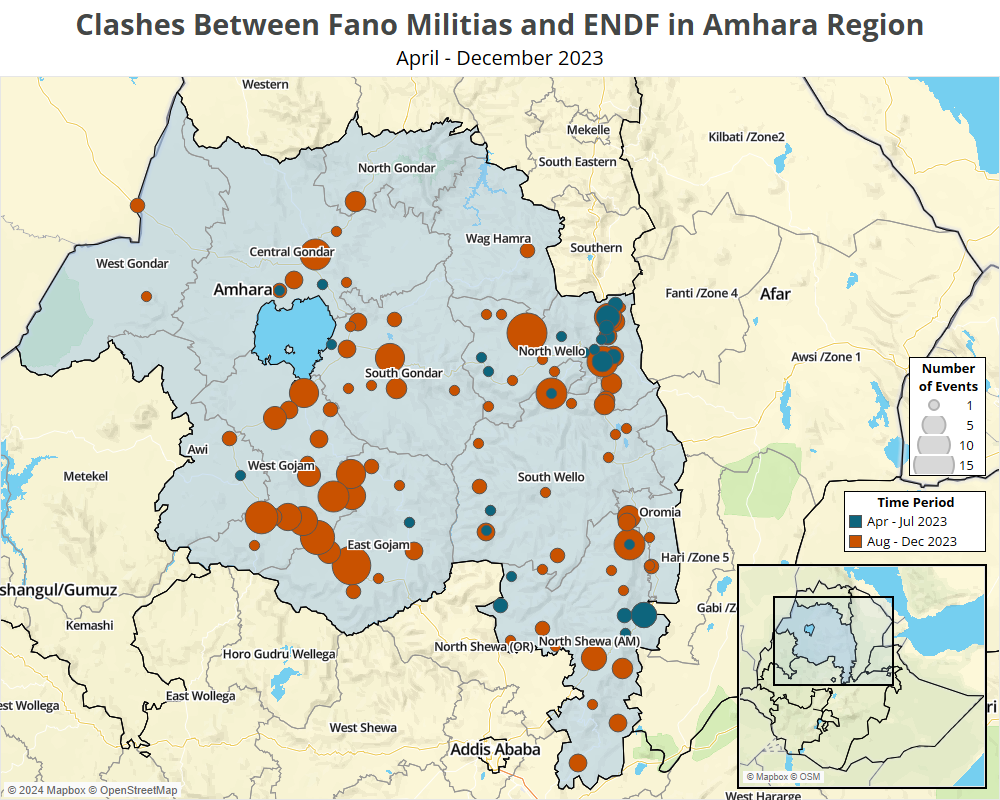December at a Glance
VITAL TRENDS
- In December, ACLED records 127 political violence events and 361 reported fatalities in Ethiopia.
- The most political violence in December — with 62 events and 148 reported fatalities — was recorded in Oromia region, where the Oromo Liberation Army (OLA) — referred to by the government as the Oromo Liberation Front (OLF)-Shane — clashed with government forces.
- In December, battles and violence against civilians were the two most commonly recorded event types, with 78 and 42 events, respectively. The overall recorded incidents of political violence decreased by 31% throughout the country.
KEY DEVELOPMENTS

The Fano Insurgency: Main Hurdles to Unifying Fano
Over the past 10 months, Fano militias have been battling the Ethiopian National Defence Force (ENDF) in locations throughout Amhara region. Clashes began in April 2023 shortly after the federal government announced a plan to dissolve the regional special forces and integrate them into other security sectors. Since then, the Fano insurgency has flared, dipped, and then risen steadily. Violence patterns of the insurgency have been characterized by the group’s decentralized nature — Fano militias spread throughout the country have yet to coalesce into a single movement despite sharing a common name. This report examines the Fano insurgency over the past 10 months and discusses the barriers Fano has faced, its efforts to overcome these challenges, and the road ahead.
Decoding the Fano Insurgency
‘Fano’ refers to a group of armed youth, generally from Amhara region, who are involved in community protection. The term took on new connotations under the later years of the Ethiopian People’s Revolutionary Democratic Front (EPRDF) — 2014-2018 — when it became synonymous with an anti-government youth movement that led massive non-violent protests and a limited violent insurgency in Amhara region. Prior to the northern Ethiopia conflict, Fano militias expanded substantially, with popular figures rallying groups of fighters around reports of attacks on ethnic Amhara in Oromia and Benshangul/Gumuz regions, and around the territory claims of Raya and Welkait in Tigray region. During the northern Ethiopia conflict, Fano militias were allied with the federal government and given weapons and training, taking and controlling western parts of Tigray region at the outset of the war.1Human Rights Watch, ‘”We Will Erase You from This Land” Crimes Against Humanity and Ethnic Cleansing in Ethiopia’s Western Tigray Zone,’ 6 April 2022 Even prior to the end of the northern Ethiopia conflict — which ended in November 2022 — the relationship between Fano and the federal government began to sour as the government attempted to disarm and demobilize the group.
Violence flared in Amhara region in April 2023 with the announced disbanding of regional special forces, declining throughout May and June as ENDF forces took control of Amhara region and arrested Fano militia members and supporters. In July, violence rose again as Fano militias began to regroup and better organize (see graph below). Violence in the region peaked in August 2023 and has remained at high levels since. In December, 34 battles were recorded between ENDF and Fano militias. The ENDF conducted at least three drone strikes, resulting in an estimated 50 reported fatalities. Political violence in the region led to an estimated 200 reported fatalities in December. In any conflict, fatality information is the most biased and least accurate part of any conflict report. In Amhara region, the rural nature of the conflict environment and some communication difficulties have made confirming reports difficult. Sources in Amhara region, as interviewed by ACLED analysts, suggest that the actual number of fatalities is likely to be much higher than estimated.

Like the OLA/OLF-Shane in Oromia region, the Fano militias have been able to successfully control many rural locations in Amhara region, while in urban areas they generally conduct ambush attacks against ENDF targets and political opponents. The most extreme branch of Fano is thought to have been responsible for a spate of assassinations in Amhara region, including the April 2023 killing of the head of the Amhara Prosperity Party.
In December, most fighting between Fano militias and government forces was concentrated in Wegeltena kebele in South Wello zone, in Dega Demot kebele in West Gojam zone, and in towns and villages between Shewa Robit and Kombolcha towns in North Shewa zone along the A2 highway.
Barriers to Uniting the Fano Insurgency
Fano militias enjoy high support from the general public in Amhara region and gained valuable conflict experience and equipment during the northern Ethiopia conflict. After the Amhara regional special forces were disbanded, many members joined Fano militias, adding thousands of individuals with training and weapons to the movement’s ranks.2Ethiopia Insider, ‘Among the scattered members of the special forces of the Amhara region; The Minister of Peace stated that “most” have joined armed groups,’ 15 August 2023 Despite this, Fano militias face serious political, geographical, and logistical issues that have impeded their ability to combat the ENDF. Like the OLA/OLF-Shane insurgency in Oromia region, Fano successfully challenges the federal government to a certain degree but struggles to put forth a viable alternative due to a lack of unity, weak or unclear political stance, and the absence of a clear plan for the future.
As a principle, Fano militias are a decentralized organization with little administrative structure beyond the village level.3Jeff Pierce, ‘“The government has much tears and blood on its hands” — A Brief Exclusive Interview with Eskinder Nega,’ Medium, 8 September 2023 Politically, the group cannot be ascribed to a single ideology, although all individuals recognized as leaders within the Fano movement gained their popularity through advocating for the rights and interests of ethnic Amhara. The group’s most extreme elements gather support by rallying around territorial interests and warning of impending Oromo domination, advocating for Amhara ethno-nationalism in its most extreme forms. Colonel Demeke Zewdu, often recognized as the founder of the modern Fano movement, gained his popularity through advocating for ethnic Amhara’s claim on the Tigray-administered Welkait, Tsegede, and Tselemt and for his actions during the northern Ethiopia conflict.4Noé Hochet-Bodin, ‘Demeke Zewdu, the warlord who wants to avenge the Amhara in Ethiopia,’ Le Monde, 30 April 2022 On the other side of the spectrum are those that promote a wider Ethiopian identity, making Fano the force that could preserve Ethiopia as a whole,5Interview with Fano militia member, conducted by the EPO researcher in Gondar city on 21 April 2021 and not just those in Amhara region. Historically, popular Amhara opposition figures like Zemane Kassie — a former member of the Ginbot 7 anti-government insurgency and now the leader of the Gojam Amhara Fano movement — have blamed Ethiopia’s ethno-federalist system as implemented by the EPRDF as the root cause of the country’s woes, and instead advocated for a greater Ethiopian identity that transcends the country’s ethno-political system and places rights with the individual.6Ginbot 7, ‘Unity, May 7, Freedom, Justice, Unity, Part 1,’ YouTube, 2018
Another prominent example of this phenomenon is Eskinder Nega, founder of the Balderas for True Democracy Party (Balderas Party) and now leader of the Amhara Popular Front, an anti-government militia base in Amhara region allied to Fano. As the leader of the Badaras Party, Eskinder focused on human rights and issues that affected residents of Addis Ababa — particularly the claims that Oromia region holds on the capital city.7Opride, ‘Oromia Special Interest Law: Who owns Addis Ababa?,’ 1 July 2017 Eskinder has captured the support of many in the diaspora but has struggled to rebrand himself well enough to gain the loyalty of a significant number of Fano militia groups. In May 2023, Eskinder’s followers were involved in battles against ENDF forces in Debre Elias woreda, East Gojam zone, Amhara. Recently, the Amhara Popular Front was renamed to the Amhara People’s Fano Front. Justifying the pivot, Eskinder has stated that the ethnic focus in Amhara region was a “byproduct of the ongoing state-sponsored leveling, categorization, demonization, mass displacement, and mass killing of Amharas.”8Jeff Pierce, ‘“The government has much tears and blood on its hands” — A Brief Exclusive Interview with Eskinder Nega,’ Medium, 8 September 2023
Political differences causing a lack of a clear united front have arguably contributed to the initial success of Fano militias in controlling many parts of Amhara region. Government arrests of Fano leaders had little impact on the group due to its decentralized nature. However, Fano’s lack of unity has hindered the group’s efforts to expand its influence and compete politically with the government — both within Ethiopia and among the Amhara diaspora.9Addis Insight, ‘An Open Letter to Major Dawit W/Giorgis and Mr. Getahew Beyene,’ 11 January 2024 This lack of unity is similar to the fractured Oromo elite both within Ethiopia and among the diaspora population, which has hampered the OLA/OLF-Shane insurgency’s ability to mobilize resources further.
The significant division between religions in Ethiopia is another factor behind the lack of organization among various Fano militias. Populations in the eastern part of Amhara region are mostly Muslim, while those in the west are predominantly Orthodox Christians. In Amhara’s west, Amhara identity is deeply intertwined with the Orthodox Church. Violent interactions between the two religious groups have occurred on occasion in Amhara region. In April 2022, 20 Muslims were killed in Gondar city during riots that targeted those attending the funeral of a local sheikh.
Timing has also played a significant role in the Fano insurgency. Early action by the federal government in arresting recognized Fano supporters in Amhara region and in Addis Ababa has made overcoming political and geographical differences even more challenging for Fano. However, there is evidence that the Fano movement is regrouping. Fano militias in Gojam recently (as of November 2023) elected a common leader, as have groups in eastern (Misrak) Amhara region. The Amhara Fano Unity Council, formed in May 2023, is another force that has had some success in advocating for a more consolidated resistance effort by Amhara people against the federal government.10Ethiopia Insight, ‘Amharas turning on Abiy are short of Ethiopian allies,’ 7 June 2023 Violence patterns as recorded by ACLED indicate that as Fano militias have become more organized, clashes have increased, and the group has gained a greater ability to challenge the ENDF in more places (see map below).

What’s to come?
The government’s recent calls inviting Fano fighters to disarm and reintegrate have been welcomed by some, although the continued escalation of fighting suggests that the overall impact of these calls will be minimal.11Amhara Media Corporation, ‘More than 5,000 militants chose peace and entered the centers,’ 5 December 2023 Rather, it is likely that the Fano insurgency will continue for a long period of time or until there is a major shift in political trajectory. Implementing decisions about contested territory in Western and Southern Tigray zones — under the control of Fano militias but recognized as part of Tigray region — is likely to spark a rise in clashes.
The likelihood of a lengthy insurgency in Amhara region has serious humanitarian implications. The region is already experiencing difficulties stemming from the destruction of infrastructure that occurred during the northern Ethiopia conflict. Security issues have complicated the transport of aid to needy populations in Amhara and Tigray regions.12Amhara Media Corporation, ‘Security problems and humanitarian aid,’ 1 January 2024
Correction: An earlier version of this report stated that Zemane Kassie was the leader of the Gondar Amhara Fano movement. It has been corrected on 24 January to say Zemane Kassie is currently the leader of Gojam Amhara Fano movement.





